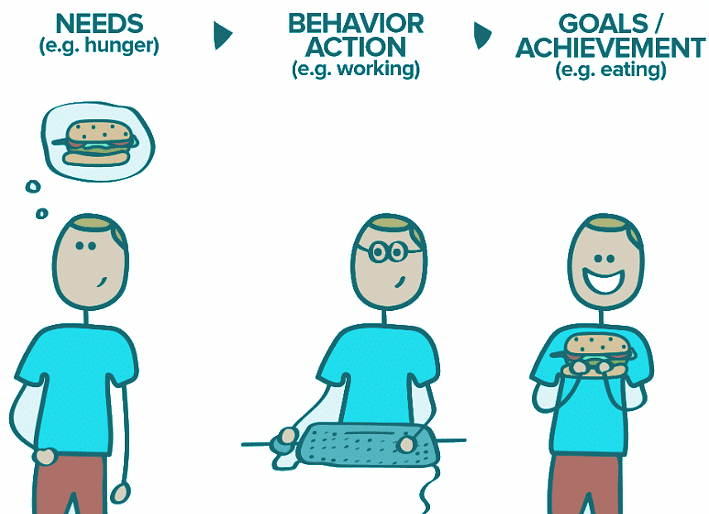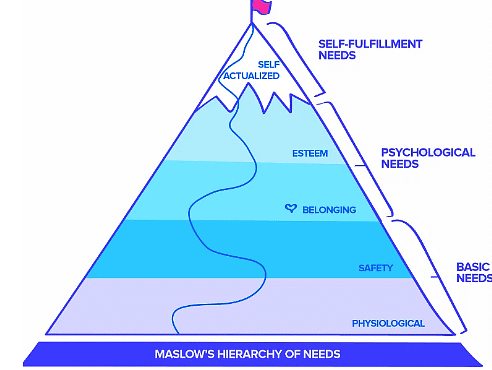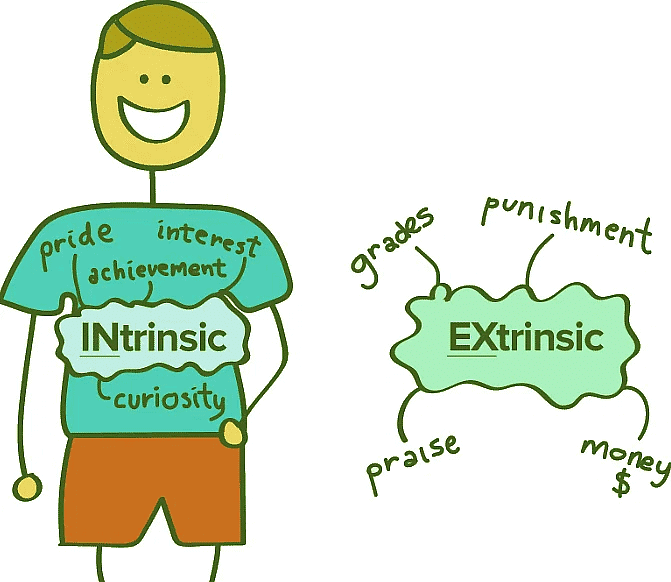MCAT Exam > MCAT Notes > Psychology and Sociology for MCAT > Understanding Motivation: What Drives Us to Achieve
Understanding Motivation: What Drives Us to Achieve | Psychology and Sociology for MCAT PDF Download
| Table of contents |

|
| Introduction |

|
| The Basic Model of Motivation |

|
| Different Types of Needs: |

|
| Hierarchy of Needs |

|
| Intrinsic and Extrinsic Motivation |

|
| The Power of Written Goals |

|
Introduction
Motivation is a powerful force that compels us to take action, even when faced with challenges or mundane tasks. It is what propels us out of bed in the morning, drives us to eat, brush our teeth, go to school or work, and engage in physical exercise. While these activities may seem optional, many of us instinctively feel the need to fulfill them. In this article, we will delve into the fundamental aspects of motivation and explore the various factors that influence our drive to accomplish tasks.
The Basic Model of Motivation
At its core, motivation is driven by our needs. These needs can take on different forms, ranging from emotional desires to biological requirements. Throughout our lives, our thoughts, beliefs, feelings, environment, culture, and social relationships shape our understanding of what we need at any given moment. When our needs are unfulfilled, we may experience a sense of purposelessness or a feeling that something is missing from our lives. Consequently, we strive to bridge this gap and satisfy our needs. For example, if the aspiration to attend medical school becomes a significant need, we become motivated to excel in biology and chemistry classes, achieve high grades, and complete applications to preferred institutions. If we succeed in gaining admission to medical school, we experience a sense of fulfillment. However, this achievement often gives rise to new goals and needs, illustrating the dynamic nature of motivation.

Different Types of Needs:
Motivation theories categorize needs into three primary groups: physiological needs, psychological needs, and learned needs. Each category highlights distinct aspects of human motivation and sheds light on the factors that drive our behavior.
- Physiological Needs: Physiological needs are fundamental, biological requirements essential for our survival. These needs, such as hunger, thirst, and pain avoidance, are regulated by our body's internal systems and are present from birth. Motivation theories focusing on physiological needs emphasize homeostasis, the body's ability to maintain internal stability, and our natural circadian rhythm. Drive reduction theory, one such theory, suggests that motivation arises from the desire to reduce internal tension or restore balance. For instance, feeling hungry triggers the release of hormones, prompting us to eat and restore balance within our bodies. Similarly, when experiencing a headache, we take medicine to alleviate the pain, addressing the underlying issue signaled by our body.
- Psychological Needs: Psychological needs stem from our thoughts, feelings, beliefs, expectations, and self-image. These needs are crucial for our mental well-being and contribute to a sense of balance and harmony within ourselves. Cognitive dissonance theory explores psychological needs, suggesting that when there is a significant disparity between our thoughts or beliefs and our actions, we experience discomfort or unhappiness. This discomfort compels us to modify our behavior to align it with our beliefs, thus alleviating the distress. For example, if we hold the belief that honesty is paramount and lying contradicts our values, engaging in dishonesty will generate feelings of anxiety and discomfort. To restore harmony, we are motivated to act consistently with our beliefs by telling the truth, resulting in relief and the dissolution of anxiety.
- Learned Needs: Learned needs are derived from our experiences and heavily influenced by events throughout our lives. These needs encompass desires such as praise, financial success, and pleasure. Unlike physiological needs, learned needs are acquired rather than innate. Incentive theory, a prominent theory related to learned needs, posits that experiences connected to rewards enhance motivation. For instance, libraries may offer a pizza party as a reward for children who read a certain number of books during the summer. In this scenario, children who desire the prize are motivated to work diligently and read the required books. Similarly, as adults, we often seek financial bonuses or rewards from our jobs, which function as learned needs. Social relationships and cultural influences can also shape our learned needs. For instance, marrying someone who places great importance on wealth and status may prompt us to alter our goals and motivations accordingly.
 |
Test: Motivation and Attitudes - 1
|
Start Test |
Start Test
Hierarchy of Needs
Abraham Maslow, a renowned psychologist, proposed the Hierarchy of Needs theory, asserting that personal growth is only possible once basic needs are met. According to this theory, needs can be classified into three categories: basic needs, psychological needs, and self-fulfillment needs. Basic needs, including access to food, water, air, and a safe environment, must be fulfilled before pursuing higher goals, such as forming relationships or developing positive self-esteem. As each level of need is satisfied, individuals gain the motivation to pursue happiness and personal growth. For instance, someone who lacks a home, sufficient food, or a safe environment may not prioritize creative self-expression or professional recognition. Conversely, individuals who feel secure in a nurturing environment are more inclined to strive for achievements at work or in their communities. Maslow believed that by fulfilling their needs, individuals become motivated to become their best, most creative, and happiest selves.

Intrinsic and Extrinsic Motivation
- Motivation can be classified into two broad categories: intrinsic and extrinsic motivation. Intrinsic motivation arises from internal factors, such as personal enjoyment and happiness derived from engaging in a particular activity. For example, someone working for a snowboard company may be intrinsically motivated because they love snowboarding and find fulfillment on the slopes.
- Extrinsic motivation, on the other hand, is driven by external factors like monetary rewards, recognition, obligations, or approval from others. In the snowboard company example, the individual may aim to sell a specific number of snowboards to earn financial incentives or receive praise from their superiors. Both intrinsic and extrinsic motivation play crucial roles in setting and achieving goals. In many cases, individuals incorporate both types of motivation when determining their objectives. The combination of intrinsic and extrinsic motivation can foster a more productive and fulfilling work environment. By aligning tasks with employees' interests and goals, managers can harness their intrinsic motivation and enhance their overall motivation levels.

The Neuroscience of Goal Achievement
Setting and accomplishing goals not only provides a sense of fulfillment but also triggers the release of dopamine in our brains. Dopamine, a chemical associated with pleasure, reinforces our motivation by rewarding us with positive feelings upon goal achievement. This neurochemical response strengthens our drive to continue setting high standards and pursuing further accomplishments.
 |
Download the notes
Understanding Motivation: What Drives Us to Achieve
|
Download as PDF |
Download as PDF
The Power of Written Goals
Many experts believe that the act of writing down goals increases the likelihood of achieving them. When setting goals, it is essential to make them specific, outline the necessary steps, and establish a timeframe for completion. For instance, rather than a vague goal like "I will lose weight," a more effective approach would be to write, "I will lose 10 pounds in 6 months by running 2 miles three times per week and attending a yoga class four times per week." This specificity provides clarity and direction, making it easier to track progress and stay motivated.
The Influence of Friendships
The motivation levels of our friends can significantly impact our own drive and ambition. When surrounded by highly motivated friends who actively set career or health goals, we are more likely to emulate their behavior and become high achievers ourselves. Therefore, nurturing friendships with individuals who possess a strong sense of motivation can inspire and propel us towards greater accomplishments.
Conclusion
Motivation is a multifaceted force that drives our actions and shapes our lives. Understanding the various types of needs that motivate us—physiological, psychological, and learned—provides valuable insights into the intricacies of human behavior. The Hierarchy of Needs theory highlights the importance of fulfilling basic needs as a foundation for personal growth.
The document Understanding Motivation: What Drives Us to Achieve | Psychology and Sociology for MCAT is a part of the MCAT Course Psychology and Sociology for MCAT.
All you need of MCAT at this link: MCAT
|
339 videos|14 docs|42 tests
|
Related Searches

























